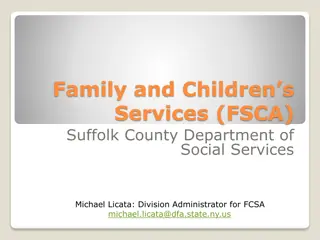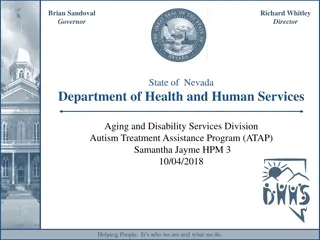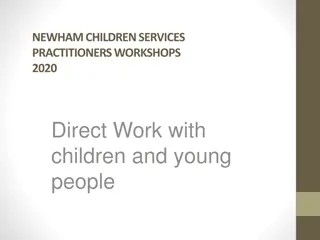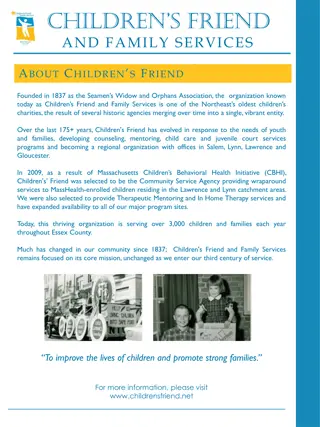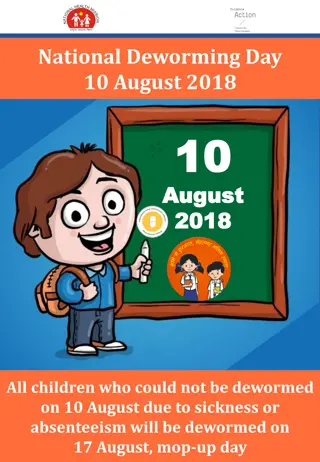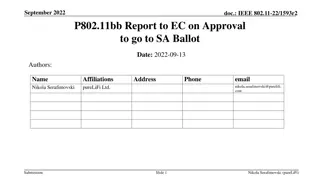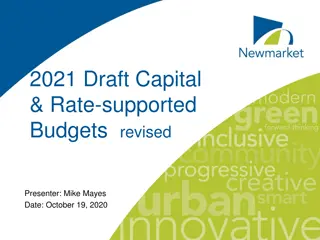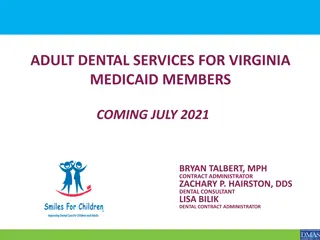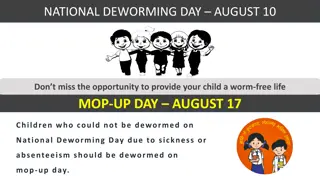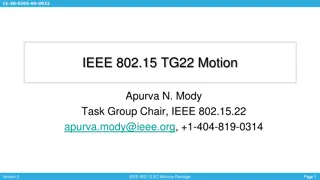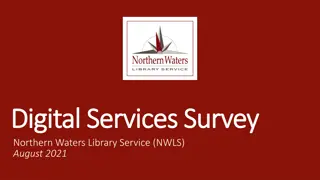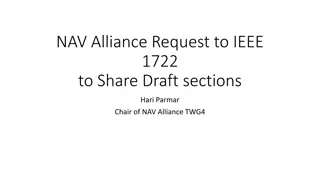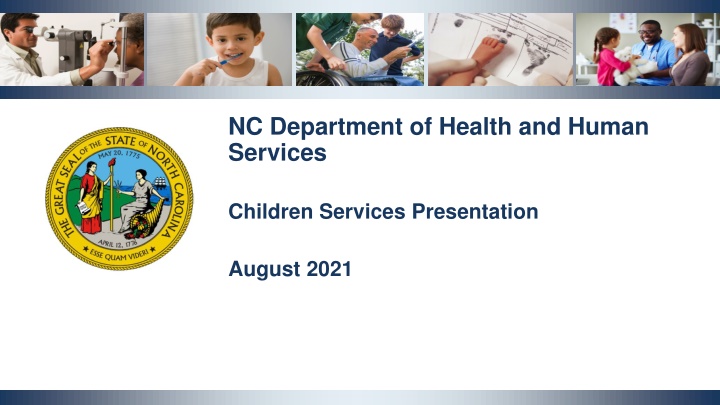
Health and Human Services Children Services: Implementation Plan Overview
Discover the progress and timeline of the Practice Standards Implementation Plan for the NC Department of Health and Human Services Children Services. Learn about the development of practice standards, leadership and staff trainings, and the training plans for supervisors. Follow along as the program moves forward with virtual training sessions, regional road shows, and a statewide webinar. Stay informed on the upcoming initiatives and activities to support a safer, more engaging, and culturally competent environment.
Download Presentation

Please find below an Image/Link to download the presentation.
The content on the website is provided AS IS for your information and personal use only. It may not be sold, licensed, or shared on other websites without obtaining consent from the author. If you encounter any issues during the download, it is possible that the publisher has removed the file from their server.
You are allowed to download the files provided on this website for personal or commercial use, subject to the condition that they are used lawfully. All files are the property of their respective owners.
The content on the website is provided AS IS for your information and personal use only. It may not be sold, licensed, or shared on other websites without obtaining consent from the author.
E N D
Presentation Transcript
NC Department of Health and Human Services Children Services Presentation August 2021 1
Where are we now? All Practice Standards are developed and finalized, with input from the Safety, Permanency, Well- Being, CQI, and Workforce Design Teams. Safety Focused Engaging Assessing Family Centered Trauma Informed Communicating Implementing Planning Culturally Competent 3
Implementation Timeline September 2021 June 2022 Leader and State Staff Trainings Fidelity Tools Train the Trainer Train the Trainer for Supervisor Training Regional Road Shows Supervisor Training Worker Training Statewide Webinar Sept Sept Oct Oct Nov Nov Dec Dec Jan Jan Feb Feb Mar Mar Apr Apr May May June June 4
Training Plan for Leaders Virtual weekly office hours for leaders to call in and ask specific questions (one- hour optional time commitment for staff) Office Hours Jan Office Hours Jan- -June 2022 June 2022 Virtual Training for Leaders. Sessions for State Office, five sessions for County Leaders (registration required, two hours) Instructor Led Training December 2021 Instructor Led Training December 2021 Opportunity for leaders to preview trainings and show support for Practice Standard implementation (one hour) Regional Road Shows October Regional Road Shows October- -November 2021 November 2021 Sets stage for upcoming training and communication, coaches, website, materials, and supports will be introduced Statewide Webinar September 2021 Statewide Webinar September 2021 (one hour)
Training Plan for Supervisors Virtual weekly office hours for supervisors to call in and ask specific questions (one Office Hours Jan- -June 2022 Office Hours Jan hour) June 2022 Short interactive videos to learn and test behaviors in each worker core activity (18 videos, three to five minutes each) Scenario Based Videos March Scenario Based Videos March- -June 2022 June 2022 In person trainings for Supervisors, focus on building skills, providing coaching and feedback (25 sessions, 10 hours each) Instructor Led Training January- -February 2022 Instructor Led Training January February 2022 Opportunity for transfer of learning and preparation for supervisor training (one session for 25 co-facilitators, eight hours) Train the Trainer for Supervisors Training December 2021 Train the Trainer for Supervisors Training December 2021 6
Training Plan for Workers Scenario Based Videos Scenario-based videos will provide workers an interactive opportunity to learn about and test the behaviors described in each core activity. Videos will be short and engaging, to align with adult learning behavior. Supervisors will also participate in completing the scenario-based videos to better understand the Worker Practice Standards. Scenario Based Videos Batting Practice Batting Practice provides Workers an opportunity to call in to a group session and ask specific questions about the Worker Practice Standards. Opportunities to role play, make suggestions, and get advice from peers. Batting Practice 7
Fidelity Tools Tools for Leaders will include: Self-Assessment Tool for Leaders Coaching Tool for Working with Supervisors Tools for Supervisors: Self-Assessment Tool for Supervisors Coaching Tool for Working with Workers Field-Based Observation Tool for Workers Documentation Review of Workers Tools for Workers: Self-Assessment Tool for Workers 8
Communications Strategies One Way Strategies One Way Strategies Two Way Strategies Practice Standard Email Address Ask questions and receive answers Roadshows County groups interact with leaders, ask questions on implementation activities Office Hours/Batting Practice For leaders, supervisors, and workers Ask questions, peer support, practice opportunities Two Way Strategies Practice Standard Email Address Bi Bi- -Weekly Emails Share leadership messaging Weekly Emails Answer FAQs Share implementation success Roadshows stories Kickoff Webinar Forum for leaders to share vision, goals, and objectives Kickoff Webinar Office Hours/Batting Practice Website Website Tools and materials posted Implementation progress 9
QUESTIONS? 10
ACF Verbal Notification to DHHS NC it will be placed in PIP status because it s policy on IV-E claims for candidacy for foster care is not in compliance ACF plans to use the PIP process to formally approve and supervise North Carolina s coming into compliance with law in the federal social security act For this reason, DHHS has delayed implementing new policy related to candidacy claims discussed in June 12
Timing of the PIP ACF notified DHHS it will receive a formal letter notifying it of the PIP process. After receiving the letter, NC will have: One month to complete and submit its PIP to ACF. A maximum of 12 months to complete the PIP and come into compliance NC has not yet received the formal letter 13
Other Details Verbally Provided by ACF NC and its counties will be allowed to continue to submit claims to IV-E for candidacy while working on the PIP The PIP status will be specific to candidacy. Any DHHS child welfare policy cited as evidence of NC s compliance with federal law related to IV-E claiming must carry the weight of law in North Carolina. 14
What Counties Should Expect and Do Counties should claim administrative costs for candidates for foster care to IV-E only for children who meet the definition in the CB policy manual. Briefly: The child must be at imminent or serious risk for entering foster care The county must be making reasonable efforts to prevent removal described in a case plan developed together with the family that documents why the child is at serious risk of removal. DHHS will be conducting a thorough review of federal IV-E plan requirements 15
Title IV-E Prevention Plan 1. Final Stage of Review 2. Review and Approval Process 3. Submission in August 4. Next Steps 17
Original Phased Candidacy Approach Phase 2: Phase 3: Phase 1: Phase 1 candidates Children Exiting foster care Families with a Screened- Out CPS report Phases 1 & 2 candidates Voluntary Requests for Services Families Identified as High Risk by Community Agencies Children Receiving In Home Services Children Exiting In Home Services Pregnant and Parenting Youth in Foster Care 18
Candidacy Approach Phase 1: Children Receiving In Home Services who meet the federal candidacy definition Pregnant and Parenting Youth in Foster Care 19
EBP Status Update Homebuilders- Family Systems Intervention- In Home Skill Based Parenting Child Behaviors/Family Functioning/Parental Factors in managing home environment, linking to services to support family, stabilize crisis. Serves all 0-18. Parents as Teachers- Family Systems Intervention- In Home Skill Based Parenting Early supports for families/children at risk. Child behavior/Parent Functioning/Parent Behaviors. Addresses early childhood emotional development. Serves ages 0-5, in home model 20
Family First Specific Training Plan Coaching for workers, supervisors, resource parents, and other stakeholder groups on Family First prevention services implementation. Coaching Coaching Training to specifically support supervisors in their role of assisting staff in identifying family candidates, family engagement, and service alignment and linkage. Supervisory Training Supervisory Training The training will include the agency s vision for family services and how the Family First legislation will serve as a lever for child welfare system transformation In In- -person training to include all new onboarding staff person training to include all new onboarding staff Family First Prevention Service Act Online On-demand course(one hour) Virtual Platform All Existing Staff Virtual Platform All Existing Staff 21
Family First Prevention Services Act October 1, 2021 Evidence-Based Prevention Services Post Permanency Services and Supports Reduce the Need for Foster Care & Congregate Care Foster home standards Kinship care Therapeutic Foster Homes 22
Congregate Care October 1, 2021 Effective October 1, 2021, federal IV-E reimbursement for new placements in congregate care will be limited to 14 days. Four types of placements are exempt from the 14 days limit for non-foster family placement settings. Pregnant and Parenting Teens Youth Transitioning At Risk for Sexual Exploitation QRTP (exempt from 14 days limit but time frames and certain activities must be adhered to claim) Administrative claiming continues beyond the 14 days for those IV-E eligible Psychiatric Residential Treatment Facilities (PRTFs) are claimed under Medicaid and are not impacted because they do not receive a foster care board rate. 23
Continuity of Care: Transformation and Placement Array Reducing congregate care is a transformative effort that will require resource allocation and capacity building. NC recognizes that some children have needs that are better served in a non-home/non-family-based setting. QRTPs are part of a service expansion that may best serve the needs of those children. 24
Bridge Funding If sufficient funding is available, we intend to create a two-year glide path for counties and the state to help reduce disruption due to funding loss. provide a bridge while the child welfare system adapts to the new financial incentives created by FFPSA. Depending on additional state funding availability, bridge funding plan is variable but requested counties held harmless from federal funding loss in SFY22, then a 50/50 state/county share in SFY23. 25
Budget Implications Fiscal Impact on the Foster Care Program Budget. (projection includes valuing initial 14-day payment allowability). Fiscal impact in the first year estimated to be $5.8M reduction in federal funding. The second-year impact is expected to be approximately $11.1M reduction. The ongoing annual effect estimated at a $15.3M reduction if system shift away from congregate care is not accomplished. 26
QRTP Preparation A functional assessment tool for children in congregate care Data to inform you of the current and potential congregate care Understanding the role QRTPs would play in the placement array Identifying essential partnership components to create quality settings for youth with higher clinical needs Knowing the change QRTPs represent and how that would be different from the current approach 27
Gearing up for: Statewide recruitment of foster parents RCWC working with counties Increase Kinship placements 28
NC needs: Increased number of licensed foster and kinship homes Adequate support to kinship and foster care homes Timely access to behavioral health treatment beds Timely access to wrap around supports and other behavioral health services to meet the needs of children and youth in foster care Respite for caregivers Expansion of crisis supports to meet the needs of children, youth, and their caregivers to provide support quickly and reduce hospitalizations 29




